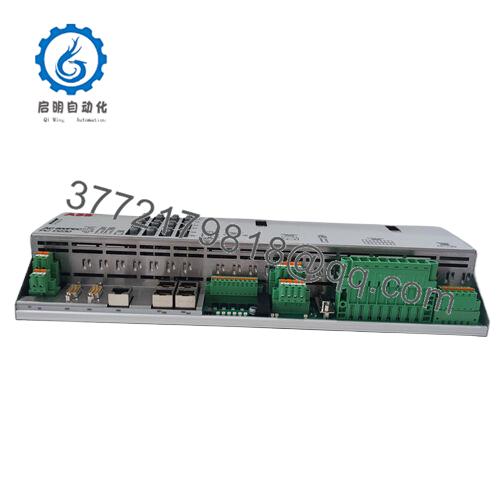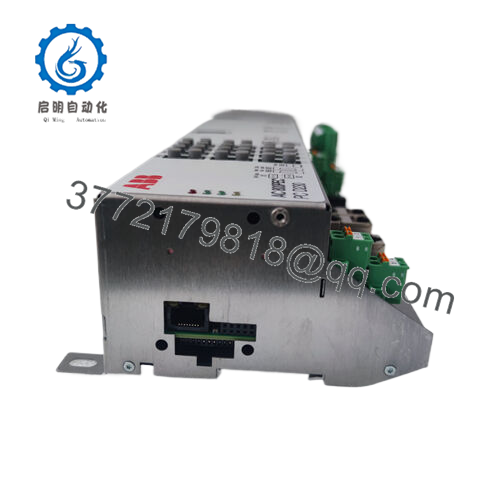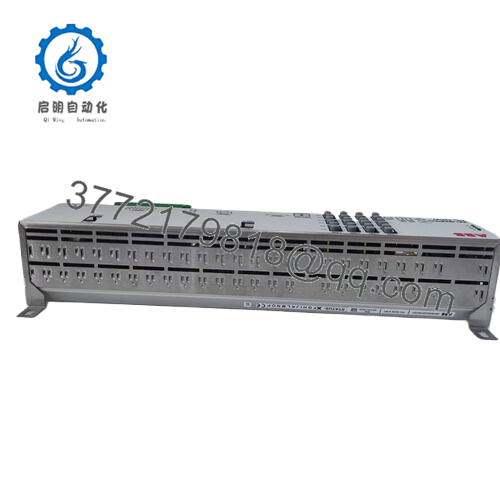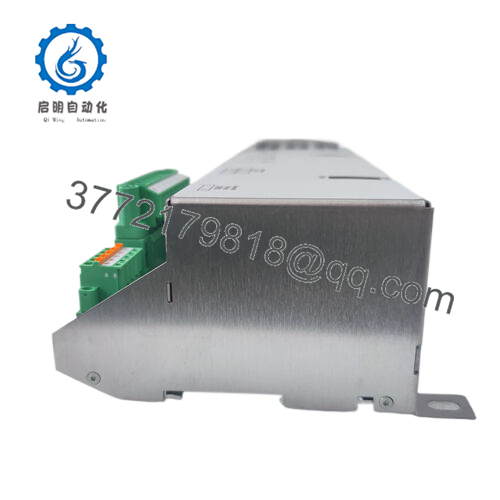Description
In the high-stakes domain of power generation, where synchronous generators demand instantaneous excitation adjustments to counter voltage sags or load transients, the shortfall of a dedicated communication and measurement backbone can precipitate rotor instability, harmonic distortions, or outright grid excursions—scenarios that not only erode efficiency in hydro or thermal plants but also invite cascading failures in interconnected networks, ballooning repair timelines and compliance penalties. Visualize a peaking station where sluggish field flashing delays synchronization, or a pumped-storage facility where imprecise rotor current feedback triggers overfluxing, compromising turbine longevity and operator confidence amid volatile renewables integration. These exigencies spotlight the role of a robust interface module that synchronizes control commands with real-time metrics, and that’s exactly the territory the ABB PCD230A101 3BHE022291R0101 claims as a Communication Control and Measurement (CCM) unit in the AC 800PEC series, tailored to fortify excitation systems with seamless data orchestration for unwavering process control.
Engineers commissioning or overhauling UNITROL 6000 setups often contend with modules that bottleneck Modbus exchanges or falter in aggregating PT/CT signals under dynamic faults, yielding fragmented diagnostics that prolong fault isolation and undermine high reliability in mission-critical grids. The ABB PCD230A101 3BHE022291R0101 intervenes decisively, serving as the nexus for protocol bridging and sensor fusion in PEC80-CCM configurations, where it handles serial comms alongside voltage/current sampling to sustain generator stability during brushless excitations or AVR handoffs. It’s pivotal in environments like industrial cogeneration or offshore wind farms, where industrial automation hinges on sub-second latency to preempt underexcitation alarms, forestalling the operational voids from misaligned field boosts that cascade into revenue shortfalls. Sans this integration layer, you’d navigate custom gateways or manual polling hacks, reallocating bandwidth from predictive modeling to perpetual patchworks in the grind of 24/7 synchronization.
Amid the pivot to hybrid grids laced with solar intermittency, the yearning escalates for CCM modules that infuse redundancy without encumbering rack space. The ABB PCD230A101 3BHE022291R0101 delivers via its embedded FPGA for parallel processing, galvanically isolating field inputs to thwart noise ingress while supporting duplex modes for failover resilience—repositioning disparate signals into a unified stream for 800xA oversight. This isn’t plug-in expediency; it’s the conduit that distills excitation telemetry into actionable foresight, enabling your squad to dissect transients via trend logs rather than dissecting post-mortems. In norm-bound theaters like utilities or marine propulsion, where IEEE 421.5 adherence governs stability margins, it cements signal reliability that accommodates scaling toward microgrid autonomy, crafting a scaffold for resilient, data-centric automation.
| Specification | Details |
|---|---|
| Model Number | 3BHE022291R0101 |
| Brand | ABB |
| Type | Communication Control and Measurement Module |
| Input Voltage | 24 V DC |
| Operating Temp Range | 0°C to 55°C |
| Mounting Style | DIN Rail (PEC80 Rack) |
| Dimensions | 375 x 133 x 70 mm |
| Weight | 1.8 kg |
| Interface/Bus | Modbus, CEX Bus |
| Compliance | CE, UL, RoHS |
| Supported Protocols | Modbus RTU/TCP, PROFIBUS |
| Typical Power Draw | 10 W |
The ABB PCD230A101 3BHE022291R0101 occupies the coordination tier in your excitation architecture, interfacing PT/CT transformers and rotor sensors via analog front-ends to digitize metrics like field voltage or armature current, then multiplexing them over the CEX bus to upstream controllers like the PCD235 for AVR computations—nestle it in a PEC80 enclosure as the data aggregator that decouples measurement noise from control pulses, ensuring clean handoffs to the broader AC 800PEC stack without latency spikes. This perch optimizes it for field-level deployment, where it preconditions signals with 16-bit ADCs before serializing to Modbus slaves, embodying the vigilant curator in a symphony of stator fluxes and thyristor firings.
What elevates its system rapport is the layered finesse: onboard isolation up to 2 kV shields against thyristor transients, with configurable scan rates down to 1 ms for capturing di/dt surges, piping health pings back to engineering tools for HMI syndication. Termination headers accommodate shielded pairs for EMI-riddled bays, and its PROFIBUS spine ties legacy exciters to Ethernet backbones, fostering hybrid dialogues without protocol proxies. In redundant weaves, it shadows a mate for bumpless swaps, upholding metric flows amid hot maintenance. Upstream, it seeds setpoint tables from sequence logic; downstream, it arms firing angle calcs, all provisioned through PCM600 suites that obviate ladder rewrites. For evolutions, the ABB PCD230A101 3BHE022291R0101 scales via bus extensions, field-upgradable to ingest PMU streams, morphing your UNITROL core into a prescient hub that harmonizes disparate inputs over amplifying discrepancies.
Harnessing the ABB PCD230A101 3BHE022291R0101 infuses your excitation regimen with metric mastery that averts the anarchy of unharnessed transients, especially in loops where voltage dips could otherwise unravel synchronization and compound fuel spikes. In the vortex of load ramps, this engenders rotor poise that clings to IEEE curves—armature currents square off without overshoots, refining power factors and deferring insulation stress that lesser interfaces exacerbate, yielding kilowatt dividends and slimmer carbon footprints for your dispatch planners.
The unit’s computational sinew further liberates workflows, with parallel demodulation that tunes to harmonic profiles across seasons, obviating the seasonal recalibrations that idle exciters in transitional grids. Crews capitalize on its telemetry candor to autopsy excursions, routinely unmasking CT burdens ere they skew protections, which quickens restores and amplifies meantime-to-failure in the exchange. Forged for the ceaseless churn of baseload duty, it enshrines performance steadiness that syncs with decarbonization edicts, its frugal draw easing UPS strains in battery-augmented plants. And its rack congruence curtails retrofit rigors, latching to extant slots sans re-paneling, so your modernizations proceed paced.

PCD230A101 3BHE022291R0101

PCD230A101 3BHE022291R0101
Deeper, the ABB PCD230A101 3BHE022291R0101 cultivates extensibility: over-bus infusions graft refined filters for synchrophasor feeds, nurturing equity as UNITROL lineages layer ML-based stabilizers. This malleability lightens validation weights, with sampled epochs ratifying NERC norms devoid of adjuncts. In kernel, it’s a lodestar for lucid liaison, where adroit comms command coalesces perils from pole to plant, recasting excitation enigmas into equilibrated exemplars.
In hydroelectric cascades, the ABB PCD230A101 3BHE022291R0101 fuses governor telemetry and field probes to modulate wicket gates amid water hammer jolts, where its isolation and scan alacrity buttress critical system uptime in process control environments riven by hydraulic surges—high reliability prevails in anchoring frequency nadir sans blade flutter. Continuous uptime fortifies peak shaving without despatches.
Thermal coal units invoke the ABB PCD230A101 3BHE022291R0101 for boiler-turbine sync, aggregating exciter metrics under steam transients with Modbus resilience that counters arc furnace noise—pivotal for process control where datum depth dictates load rejection, upholding high reliability amid fossil flux.
Solar inverter farms array the ABB PCD230A101 3BHE022291R0101 to harmonize STATCOM signals in DC links, braving inverter EMI with CEX fidelity for fast data cycles that sustain grid-tie without curtailments, integral to process control environments demanding unswerving excitation amid irradiance whims.
PCD235A101 3BHE032025R0101 – Companion exciter module with integrated I/O for fuller field control in UNITROL setups. PCD231B 3BHE025541R0101 – Converter interface variant for thyristor bridging in legacy AC 800PEC evolutions. PCD232A 3BHE022293R0101 – Combined I/O sibling for analog-heavy measurement in distributed exciters. UFD128 3BHE014135R0001 – Optical module add-on for fiber-extended comms in noisy bays. PPD113 3BHE023784R2530 – Base processor for AC 800PEC backbones, enabling CCM expansions. PCD530A102 3BHE041343R0102 – Advanced CCM with Ethernet for networked grid interfaces. UCD240A101 3BHE022287R0101 – Analog output counterpart for setpoint distribution in AVR loops.
As you prime the ABB PCD230A101 3BHE022291R0101 for PEC80 insertion, corroborate bus node IDs with the controller ledger—duplicates derail polling; leverage ABB’s simware to mock this dry. Tally analog burdens to affirm ADC headroom, and scout rack vents for the 55°C cap, as stacked CCMs kindle cores—aspire to 80 CFM per shelf if convection wanes. Torque headers to 1 Nm for seismic clasp, and loop a signal generator to vet linearity, exhuming offset quirks pre-energize.
Tendency tempers to the grid’s gait. Fortnightly, cull Modbus logs for parity slips—rectify via cable audits, regreasing glands in steamy halls to repel moisture. Semiannually, drift-check converters against a precision source, annotating shifts from thermal hysteresis; in dusty realms, a blast of ionized air clears optics. Amass spectra quarterly to divine filter efficacy, often from CT saturation, and dovetail with CIGRE tests by spoofing faults. These observances, braided to logs, perpetuate the module’s metronome sans ordained pauses, surfacing sagacity that stewards spares shrewdly.




 WhatsApp: +86 16626708626
WhatsApp: +86 16626708626 Email:
Email:  Phone: +86 16626708626
Phone: +86 16626708626


